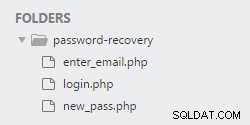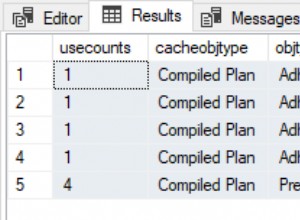He visto una implementación muy efectiva de esto que dice lo siguiente:
TABLE audit_entry (
audit_entry_id INTEGER PRIMARY KEY,
audit_entry_type VARCHAR2(10) NOT NULL,
-- ^^ stores 'INSERT' / 'UPDATE' -- / 'DELETE'
table_name VARCHAR2(30) NOT NULL,
-- ^^ stores the name of the table that is changed
column_name VARCHAR2(30) NOT NULL,
-- ^^ stores the name of the column that is changed
primary_key_id INTEGER NOT NULL,
-- ^^ Primary key ID to identify the row that is changed
-- Below are the actual values that are changed.
-- If the changed column is a foreign key ID then
-- below columns tell you which is new and which is old
old_id INTEGER,
new_id INTEGER,
-- If the changed column is of any other numeric type,
-- store the old and new values here.
-- Modify the precision and scale of NUMBER as per your
-- choice.
old_number NUMBER(18,2),
new_number NUMBER(18,2),
-- If the changed column is of date type, with or without
-- time information, store it here.
old_ts TIMESTAMP,
new_ts TIMESTAMP,
-- If the changed column is of VARCHAR2 type,
-- store it here.
old_varchar VARCHAR2(2000),
new_varchar VARCHAR2(2000),
...
... -- Any other columns to store data of other types,
... -- e.g., blob, xmldata, etc.
...
)
Y creamos una secuencia simple para darnos un nuevo valor entero incremental para audit_entry_id :
CREATE SEQUENCE audit_entry_id_seq;
La belleza de una tabla como audit_entry es que puede almacenar información sobre todos los tipos de DML:INSERT , UPDATE y DELETE en el mismo lugar.
Por ejemplo, para insertar, mantenga el old_* columnas nulas y llene el new_* con tus valores
Para actualizaciones, complete ambos old_* y new_* columnas cada vez que se modifican.
Para eliminar, simplemente complete el old_* columnas y mantener el new_* nulo.
Y, por supuesto, ingrese el valor apropiado para audit_entry_type .;0)
Entonces, por ejemplo, tienes una tabla como la siguiente:
TABLE emp (
empno INTEGER,
ename VARCHAR2(100) NOT NULL,
date_of_birth DATE,
salary NUMBER(18,2) NOT NULL,
deptno INTEGER -- FOREIGN KEY to, say, department
...
... -- Any other columns that you may fancy.
...
)
Simplemente cree un disparador en esta tabla de la siguiente manera:
CREATE OR REPLACE TRIGGER emp_rbiud
-- rbiud means Row level, Before Insert, Update, Delete
BEFORE INSERT OR UPDATE OR DELETE
ON emp
REFERENCING NEW AS NEW OLD AS OLD
DECLARE
-- any variable declarations that deem fit.
BEGIN
WHEN INSERTING THEN
-- Of course, you will insert empno.
-- Let's populate other columns.
-- As emp.ename is a not null column,
-- let's insert the audit entry value directly.
INSERT INTO audit_entry(audit_entry_id,
audit_entry_type,
table_name,
column_name,
primary_key,
new_varchar)
VALUES(audit_entry_id_seq.nextval,
'INSERT',
'EMP',
'ENAME',
:new.empno,
:new.ename);
-- Now, as date_of_birth may contain null, we do:
IF :new.date_of_birth IS NOT NULL THEN
INSERT INTO audit_entry(audit_entry_id,
audit_entry_type,
table_name,
column_name,
primary_key,
new_ts)
VALUES(audit_entry_id_seq.nextval,
'INSERT',
'EMP',
'DATE_OF_BIRTH',
:new.empno,
:new.date_of_birth);
END IF;
-- Similarly, code DML statements for auditing other values
-- as per your requirements.
WHEN UPDATING THEN
-- This is a tricky one.
-- You must check which columns have been updated before you
-- hurry into auditing their information.
IF :old.ename != :new.ename THEN
INSERT INTO audit_entry(audit_entry_id,
audit_entry_type,
table_name,
column_name,
primary_key,
old_varchar,
new_varchar)
VALUES(audit_entry_id_seq.nextval,
'INSERT',
'EMP',
'ENAME',
:new.empno,
:old.ename,
:new.ename);
END IF;
-- Code further DML statements in similar fashion for other
-- columns as per your requirement.
WHEN DELETING THEN
-- By now you must have got the idea about how to go about this.
-- ;0)
END;
/
Solo una palabra de precaución:sea selectivo con las tablas y columnas que elija para auditar, porque de todos modos, esta tabla tendrá una gran cantidad de filas. SELECT las declaraciones en esta tabla serán más lentas de lo que puede esperar.
Realmente me encantaría ver cualquier otro tipo de implementación aquí, ya que sería una buena experiencia de aprendizaje. Espero que su pregunta obtenga más respuestas, ya que esta es la mejor implementación de una tabla de auditoría que he visto y todavía estoy buscando formas de mejorarla.




